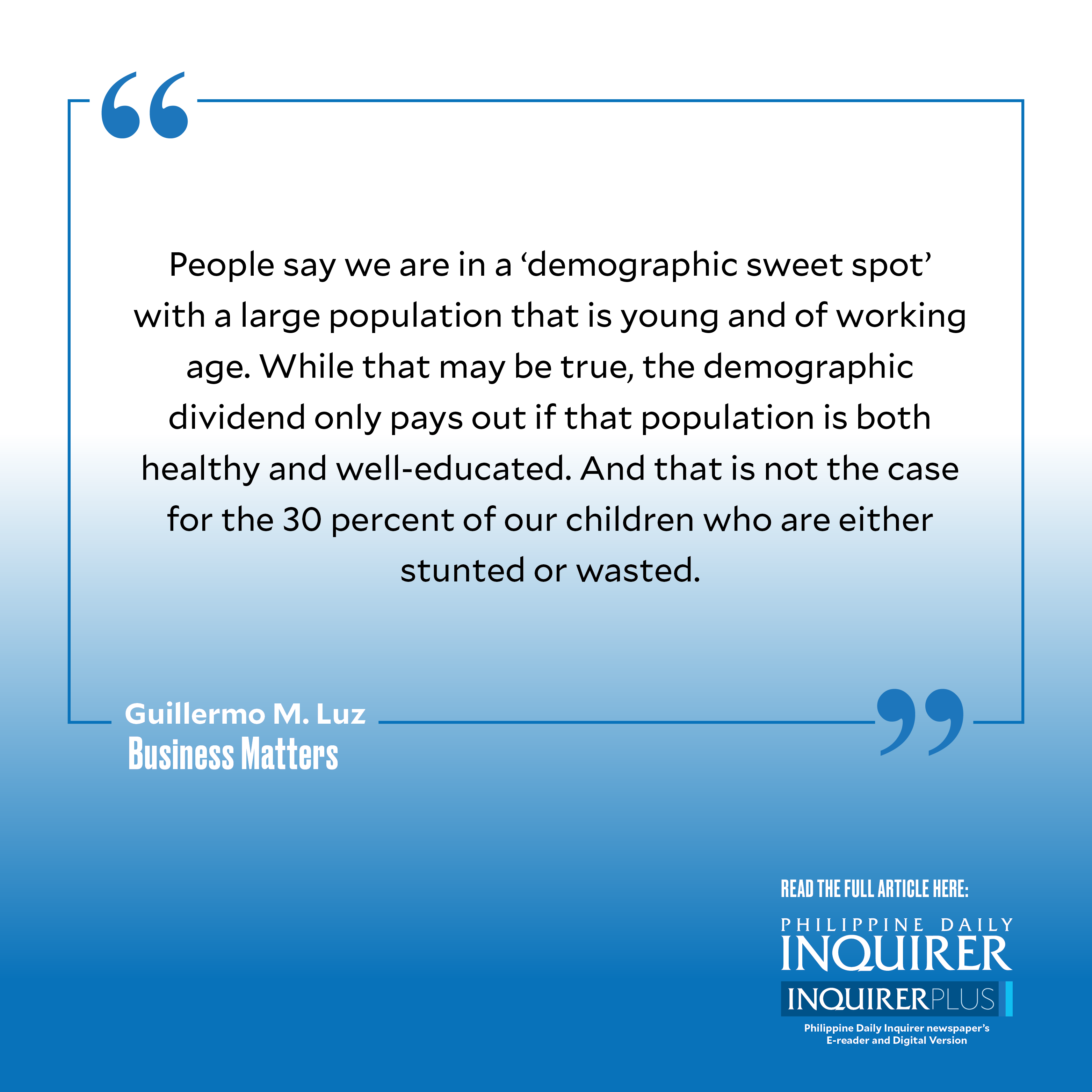The disaster unfolding before our eyes
Widespread malnutrition is perhaps one of the greatest, long-term risks facing our nation. If it continues at its current state, all the investments and effort we place on improving our education and public health systems will not be enough to offset the damage created by poor nutrition. We will just end up wasting resources trying to fix a life-long problem that can be mitigated and avoided at an early stage.
Malnutrition strikes every age group in the country, from newborn infants to the elderly. It also manifests itself in several ways. However, the most important segments are pregnant and lactating women and children from 0 to 5 years old. Problems here cascade through the entire population and lifespan of a person and have serious consequences on individual earning power and economic growth. Intervention must be prioritized on these two groups to prevent future problems.
Article continues after this advertisementMalnutrition appears in several ways.
First, there are nutritionally-at-risk pregnant women. The consequence of this are low birthweight babies, putting babies on the road to stunting, wasting, and undernutrition. This already places them at a big disadvantage early in life.
Second, there is stunting, defined as low-height-for-age. It is brought about by chronic undernutrition, usually linked to poverty, poor maternal health and nutrition, and inadequate feeding at an early age. Stunting prevents children from reaching their physical and cognitive potential. They become poor learners and eventually low earners due to their lack of skills and low productivity. Over their lives, they earn lower than healthy, educated workers and contribute less to the economy. They also become more prone to noncommunicable diseases, making them a triple burden on the educational system, public health system, and the economy.
Article continues after this advertisementThen there is wasting, defined as low-weight-for-height. This indicates recent or severe weight loss and occurs when a person has not had enough food or, more importantly, quality food. While moderate to severe wasting raises the risk of death, it is possible to reverse the trend through the availability of adequate, quality food.
Finally, there is obesity, which refers to being fat in a way that is dangerous for your health. Technically, it is measured as having a weight that is higher than what is considered healthy for one’s height; too much body mass. It is hard to imagine but obesity is on the rise in the Philippines even as malnutrition in the form of stunting is high.
In a recent survey on self-reported hunger by Social Weather Stations, 10.4 percent of families across the country experienced involuntary hunger in the second quarter of 2023. Assuming an average of five per family, that meant that 13.5 million Filipinos experienced hunger in that time period. Metro Manila had the highest reported incidence of hunger (15.7 percent) followed by rest of Luzon (11.3 percent), Visayas (9.3 percent), and Mindanao (6.3 percent).
The 2021 Expanded National Nutrition Survey reports that 33.4 percent of families are “moderately or severely food insecure.” They have insufficient money or resources to afford a healthy diet or are uncertain about their ability to obtain food or may have skipped a meal or run out of food occasionally.
The good news is that there have been improvements in the trends. The percentage of nutritionally-at-risk pregnant women has dropped from 24.7 percent to 16 percent from 2015 to 2021 (the latest available numbers). Stunting in ages 0-5 years old has dropped from 33.4 percent to 26.6 percent over the same period. Wasting for the same age group dropped from 7.1 percent to 4.8 percent from 2015 to 2021.
The bad news is that those numbers are still high—in fact, alarmingly high. For the age group 0-23 months old, that still amounts to about four million children, a significant cohort which will enter the school system in a few short years. Moreover, the problem is persistent; it takes time to see improvement. Even for the 5 to 10-year-old segment, stunting dropped from 31.2 percent to 19.7 percent from 2015 to 2021. For adolescents (12-18 years old), there were still 22.3 percent stunted in 2021 from 31.9 percent in 2015. This illustrates the cascading effect that early stunting has on later age groups. It isn’t easy to eradicate.
People say we are in a “demographic sweet spot” with a large population that is young and of working age. While that may be true, the demographic dividend only pays out if that population is both healthy and well-educated. And that is not the case for the 30 percent of our children who are either stunted or wasted.
Alarm bells should be ringing in our minds with these numbers. We need to do something to address this disaster unfolding before our eyes.
—————-
Guillermo M. Luz is chief resilience officer of the Philippine Disaster Resilience Foundation (PDRF).
—————-
Business Matters is a project of the Makati Business Club (makatibusinessclub@mbc.com.ph).

















